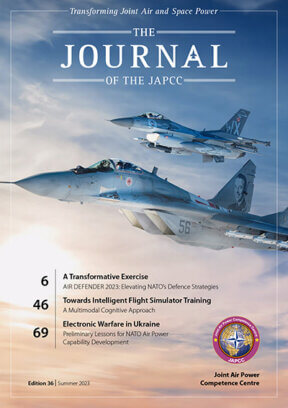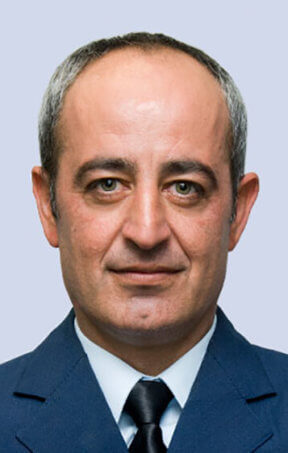Introduction
The landscape of modern warfare has undergone significant transformations in recent years, becoming far more complex and multifaceted. The parameters of this new era of warfare have broadened beyond the traditional military-focused model, encompassing a diverse array of components such as cyber, informational, economic, and diplomatic elements. This remarkable paradigm shift necessitates a thorough re-evaluation of the power concept and how it is wielded in today’s conflicts. Joseph Nye’s tripartite power framework offers an insightful perspective for analysing this evolution, elucidating the distinct yet interrelated roles of hard, soft, and smart power.1,2
Unpacking Power: Exploring Nye’s Smart Power Framework
Joseph Nye’s power framework, introduced in the 1990s, offered an innovative view of power as a multidimensional entity rather than a monolithic concept. Hard power represents the tangible elements of power, characterized by a state’s traditional military and economic capabilities, and has historically been a pillar of national security strategy.3 On the other hand, soft power denotes the subtle methods a state employs to influence others, usually achieved by projecting culture, values, and favourable policies. Despite being less tangible, soft power is equally vital, operating through attraction and persuasion instead of force. Meanwhile, smart power symbolizes a strategic blend of hard and soft power, with its application dictated by context.4
The relevance of Nye’s power taxonomy is particularly apparent in the context of current warfare, especially when distinguishing between kinetic and non-kinetic operations. Kinetic operations, including airstrikes and ground assaults, are typically associated with hard power, reflecting tangible effects. However, hard power extends beyond physical force to include non-kinetic actions that exert coercive effects, such as cyberattacks, information warfare, and economic sanctions5,6. Generally, soft power is characterized by its focus on influencing through attraction and persuasion, often manifesting in the projection of cultural appeal, ethical values, and diplomatic dialogue rather than coercive tactics. The concept of smart power, as a harmonious blend of hard and soft power, requires a holistic understanding of the potential synergies between kinetic and non-kinetic operations. It necessitates orchestration of diverse elements in a coordinated and effective manner, recognizing that non-kinetic effects may represent hard or soft power, depending on the actions taken, the context, and objectives but their combination with kinetic effect is ‘smart power’.
Charting New Terrains: Integrating Multi-Domain Operations
The escalating prominence of non-kinetic operations in the global security landscape is one of the reasons NATO has been driven to integrate Multi-Domain Operations (MDO) as a central element of its modern warfare strategy.7 MDO refers to integrating and synchronizing military capabilities across multiple domains – land, air, maritime, space, and cyber – to produce synergistic effects. This multi-domain approach is designed to enhance military operations’ overall effectiveness and efficiency.
Implementing MDO within NATO’s strategic framework aims to optimize the Alliance’s capacity to deter aggression from potential adversaries. In a world where warfare extends beyond traditional military fronts, the MDO concept is an adaptable framework that enables NATO to respond decisively and, if necessary, offensively to any form of aggression.8
The usefulness and necessity of MDO becomes strikingly apparent when considering the emergence of hybrid threats.9 These threats blend conventional and unconventional tactics, combining military and non-military means, to achieve strategic objectives. Such threats could manifest in many forms, such as cyberattacks, information warfare, economic coercion, and subversive activities designed to undermine social cohesion, political support, or effective response. Responding effectively to these multifaceted threats necessitates a flexible, adaptive, and integrated approach. This approach should cover not only traditional domains of warfare but also the increasingly significant domains of cyberspace and information operations.
NATO’s pursuit of MDO signifies its keen understanding of the evolving nature of power in modern warfare. By integrating hard and soft power capabilities and coordinating kinetic and non-kinetic operations across multiple domains, NATO seeks to enhance its ability to deter and counter potential adversaries in an increasingly complex and rapidly changing strategic environment.10
In an era where the nature of conflict is rapidly evolving, the successful application of MDO within NATO necessitates a nuanced understanding of the relationship between Nye’s forms of power and the intersection of kinetic and non-kinetic operations. By embracing the concepts of hard, soft, and smart power and adopting a multi-domain approach, NATO can effectively navigate the complex challenges of modern warfare. This dynamic approach allows NATO to maintain a robust and resilient security posture, enabling it to face a diverse range of dynamic threats with confidence and effectiveness. This flexibility and adaptability will ensure NATO’s relevance and efficacy in preserving peace and security in the coming years.
Joint Effects Synchronization: From Theory to Practice
The need to concentrate on MDO is one of the many justifications for establishing a Joint Effects Synchronization Team (JEST) at NATO HQ AIRCOM.11 However, let us not forget that ‘J’ in JEST represents ‘Joint.’ The JEST should not be merely perceived as an extra planning tool to speed up the normal process. Rather, its crucial capability is to facilitate joint planning, such that all component commands can synergize their operations and requirements, leveraging more multi-domain effects at the speed of relevance. It was always envisaged that the JEST should operate at the Joint level though it resides at AIRCOM, mainly because AIRCOM had done the work to develop the JEST.
However, the way JEST operates at the moment is too air focused; it is being used as a longer-term planning team for Integrated Air Effects in current operations rather than synchronizing joint effects. While such an air effects approach might be suitable when addressing challenges posed by Enhanced Vigilance Activities, it deviates from the core purpose for which JEST was originally established12.
Returning to joint synchronization, one of the key advantages of a correctly employed JEST is the ability to synchronize Kinetic and Non-Kinetic Operations (K/NKO). In general, such synchronization brings challenges as the planning timelines for kinetic and non-kinetic activities vastly differ. The Air Component’s traditional 72-hour Air Tasking Order (ATO) cycle does not work for Long-Range Stand-Off Weapons (LRSOW), which require 96 or even 120-hour planning windows to achieve optimum effects. Extending the planning timelines for kinetic air effects offers the opportunity to bake-in other long planning lead-times, including non-kinetic effects. This intent led to the genesis of JEST despite its current air domain focus. Shifting some aspects of air planning to a longer lead-time allows us to evaluate air activities within a broader context and paves the way for greater synchronization and strategic harmony across multiple operational sectors. It also allows for more comprehensive coordination with other extended lead-time initiatives like cyber operations, informational operations, and special operations forces activities. Such activities typically require longer planning lead times than conventional component activities, with some timelines extending into weeks rather than hours. Consequently, to ensure effectiveness, the JEST requires personnel who possess extensive background of kinetic and non-kinetic operations. Furthermore, the team should also include subject matter experts from other components, promoting a comprehensive and efficient operational planning process.
Drawing on Nye’s concept of ‘smart power’, which is about combining instruments of power, we should do the same in adaptive planning in today’s unpredictable operational environment. Through JEST’s unique approach, NATO can seamlessly transition between or even combine its kinetic and non-kinetic capabilities, providing a more adaptable and dynamic response to varying challenges.
By stepping away from the 72-hour ATO cycle, we can synchronize air effects with all other effects. For example, synchronizing LRSOW with cyber effects and electromagnetic warfare and baking some Suppression of Enemy Air Defence (SEAD) into the mix will amplify each effect. However, we must also consider the impact of our actions on the strategic communications narrative. K/NKO can either amplify, enable, or suppress each other, so they need to be synchronized to achieve the desired effect. For instance, in a peace support mission, using physical force that unintentionally results in civilian casualties can contradict our goal of promoting peace.
This synchronization requirement brings a different set of issues. Placing timelines on some non-kinetic effects is very difficult. A cyber effect can depend on many variables. For example, a member of the adversary forces may collect a judiciously placed memory stick, insert it into their network, and trigger a cyber action, but the timing of this event is entirely unpredictable. Information operations may require the adversary to believe some insidiously placed information. Media operations may require the adversary media to pick up on a particular story.
Even if we master synchronizing K/NKO, we must also consider our actions’ second and third order effects. This is especially important with NKO. Achievement of an effect using NKO often relies on influencing an enemy actor to behave in a particular way. However, humans are unpredictable and may behave in unforeseen ways with unexpected second and third order effects. These possible second and third-order effects must be considered carefully, particularly with NATO’s emphasis on protecting civilians.
Incorporating a NKO Division (NKOD) into the NATO JFAC underscores the recognized significance of NKO. However, developing a separate division creates complications to the planning process. One of the strengths of the NATO JFAC construct is that all the planners work together, allowing integration and coordination of all Air Power aspects. The NKOD has taken an electromagnetic battle staff model13. This means that the NKOD staff is embedded into all the other divisions, creating some degree of integration. Yet, despite achieving this level of integration, the wide distribution of NKO specialists challenges the value of a distinct NKOD. The planning lead time for NKO tends to be protracted, and adding a dedicated division to manage NKO seems to slow the planning process further. The key is integrating all K/NKO effects into planning. This could be accomplished by establishing a doctrinal link between the NKOD and the JEST. Each NK effect should be treated as a tool in the toolbox and applied appropriately without a separate management level. This should, by extension, lead to better integration.
There may be an argument for a NKOD in Counter-Insurgency (COIN) operations. In COIN operations, NATO will generally enjoy a high level of control of the air. Furthermore, a higher premium is often placed on NKO as they typically cause less collateral damage than KO. Combining irregular warfare factors supports a dedicated NKOD for COIN operations. Some could argue that establishing an NKO division creates a mechanism to develop and promote NKO capabilities, but in the planning world it only slows the process by developing another layer of coordination. Rather than operating through a liaison across multiple capabilities for MDO, each respective NKO SME should integrate into the planning process alongside their kinetic operations counterparts. Well-planned MDO are required against peer adversaries. This, in turn, requires flawless synchronization to achieve the overall effect. If the decision remains for a NKOD, JEST arguably becomes the vital bridge between KO and NKO. KO in concert with NKO will be needed against a peer adversary, and the synchronization between the two will be essential, leading to the requirement for a properly functioning JEST.
At the same time, we must consider the hard and soft power balance. In both K/NKO, there’s an inherent risk of collateral damage. Think of the current focus on NATO protection of civilians: it underscores the broader vision of not just achieving a military victory, but also securing lasting peace. NATO cannot afford to win the war but lose the peace. Irrespective of any tactical victories, losing the hearts and minds of the people leads to strategic defeat.14
Steps Forward
- The symbiotic integration of K/NKO is indispensable for effectively managing modern warfare. The link between NKOD and JEST is critical, ensuring that our operations evolve in harmony.
- Coordination of K/NKO is inherently a multi-domain venture, addressing challenges that necessitate comprehensive solutions. Implementation should be unified, avoiding segmented or stove-piped approaches.
- An expansion of expertise in K/NKO is required within NATO Joint Force Commands (JFC) and Component Commands (CC). This enrichment is vital to fully leverage the advantages of joint effects in Multi-Domain Operations.
- A focus on education is paramount to fostering an understanding of joint effects and empowering JFCs and CCs with capable and experienced personnel to staff the JESTs. Investing in knowledge and personnel is crucial to making a significant, positive difference.
Conclusion
The transformation of modern warfare necessitates a comprehensive, strategic, and synchronized application of hard and soft power. A more nuanced understanding of the relationship between Nye’s forms of power and the combination of kinetic and non-kinetic operations is required. The synchronization of KO and NKO is vital. The symbiosis gained by doing so gives us a vital edge in joined-up manner. To do this successfully, NATO’s JFCs and CCs will need to grow their expertise in K/NKO. Only then can the alliance leverage the strengths of Joint Effects within Multi-Domain Operations effectively. Education is needed to promote Joint effects and to allow the JFCs and CCs to fill JESTs with appropriately qualified and experienced personnel, empowered to make the difference we need.













